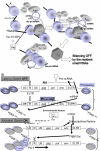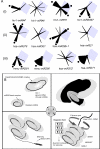RNA Genes: Retroelements and Virally Retroposable microRNAs in Human Embryonic Stem Cells
- PMID: 20835360
- PMCID: PMC2936035
- DOI: 10.2174/1874357901004010063
RNA Genes: Retroelements and Virally Retroposable microRNAs in Human Embryonic Stem Cells
Abstract
Embryonic stem cells (ESCs) are capable of undergoing self-renewal, and their developmental ability is known as the stemness. Recently, microRNAs (miRNAs) as regulators have been isolated from ESCs. Although Dicer and DiGeorge syndrome critical region gene 8 (DGCR8) are essential factors for the biogeneration of miRNA, Dicer-knockout (KO) ESCs have showed to fail to express differentiation markers and DGCR8-KO ESCs have showed to be arrest in the G1 phase. Furthermore, Dicer-KO ESCs lost the ability to epigenetically silence retroelemtns (REs). REs are expressed and transposed in ESCs, whose transcripts control expression of miRNAs, and their transposable retroelement (TE) expression is, therefore related to ESC proliferation and differentiation, suggesting that the interplay between miRNAs and REs may have a deep responsibility for the stemness including a short G1/S transition and for RE regulation in ESCs.
Keywords: ES cell; HIV-1; RNA wave.; microRNA; retrotransposon.
Figures




Similar articles
-
Functional Dissection of pri-miR-290~295 in Dgcr8 Knockout Mouse Embryonic Stem Cells.Int J Mol Sci. 2019 Sep 5;20(18):4345. doi: 10.3390/ijms20184345. Int J Mol Sci. 2019. PMID: 31491855 Free PMC article.
-
Significant differences of function and expression of microRNAs between ground state and serum-cultured pluripotent stem cells.J Genet Genomics. 2017 Apr 20;44(4):179-189. doi: 10.1016/j.jgg.2017.01.005. Epub 2017 Feb 22. J Genet Genomics. 2017. PMID: 28411033
-
Non-canonical microRNAs miR-320 and miR-702 promote proliferation in Dgcr8-deficient embryonic stem cells.Biochem Biophys Res Commun. 2012 Sep 21;426(2):183-9. doi: 10.1016/j.bbrc.2012.08.058. Epub 2012 Aug 19. Biochem Biophys Res Commun. 2012. PMID: 22925886 Free PMC article.
-
Embryonic stem cell microRNAs: defining factors in induced pluripotent (iPS) and cancer (CSC) stem cells?Curr Stem Cell Res Ther. 2009 Sep;4(3):168-77. doi: 10.2174/157488809789057400. Curr Stem Cell Res Ther. 2009. PMID: 19492978 Review.
-
Regulation of Embryonic Stem Cell Self-Renewal and Differentiation by MicroRNAs.Cell Reprogram. 2017 Jun;19(3):150-158. doi: 10.1089/cell.2016.0048. Epub 2017 Mar 9. Cell Reprogram. 2017. PMID: 28277752 Review.
Cited by
-
Transposable-element associated small RNAs in Bombyx mori genome.PLoS One. 2012;7(5):e36599. doi: 10.1371/journal.pone.0036599. Epub 2012 May 8. PLoS One. 2012. PMID: 22662121 Free PMC article.
-
Human Ribosomal RNA-Derived Resident MicroRNAs as the Transmitter of Information upon the Cytoplasmic Cancer Stress.Biomed Res Int. 2016;2016:7562085. doi: 10.1155/2016/7562085. Epub 2016 Jul 19. Biomed Res Int. 2016. PMID: 27517048 Free PMC article.
-
Transposable elements, contributors in the evolution of organisms (from an arms race to a source of raw materials).Heliyon. 2021 Jan 21;7(1):e06029. doi: 10.1016/j.heliyon.2021.e06029. eCollection 2021 Jan. Heliyon. 2021. PMID: 33532648 Free PMC article. Review.
-
Viruses and Endogenous Retroviruses as Roots for Neuroinflammation and Neurodegenerative Diseases.Front Neurosci. 2021 Mar 12;15:648629. doi: 10.3389/fnins.2021.648629. eCollection 2021. Front Neurosci. 2021. PMID: 33776642 Free PMC article. Review.
References
-
- Venter JC, Adams MD, Myers EW, et al. The sequence of the human genome. Science. 2001;291:1304–51. - PubMed
-
- Mattick JS, Makunin LV. Non-coding RNA. Hum Mol Gene. 2006;15:R17–R29. - PubMed
-
- Costa FF. Non-coding RNAs, epigenetics and complexity. Gene. 2008;410:9–17. - PubMed
-
- Valeri N, Vannini I, Fanini F, et al. Epigenetics, miRNAs, and human cancer: a new chapter in human gene regulation. Mamm Genome. 2009;20:573–80. - PubMed
-
- Evans MJ, Kaufman MH. Establishment in culture of pluripotential cells from mouse embryos. Nature. 1981;292:154–6. - PubMed
LinkOut - more resources
Full Text Sources
Research Materials
